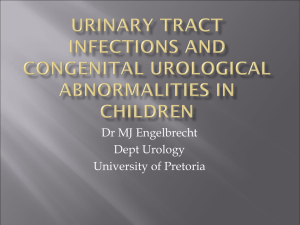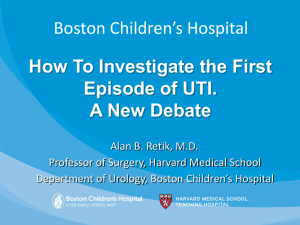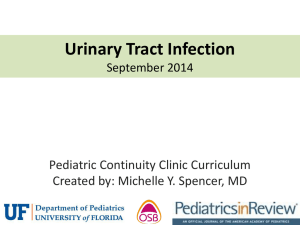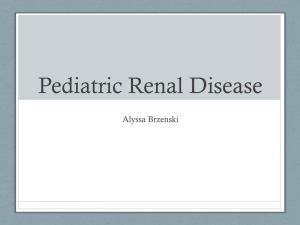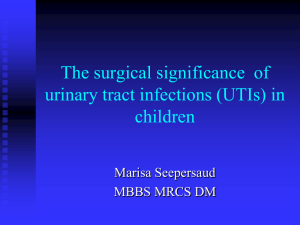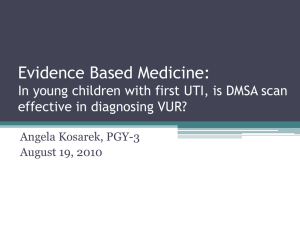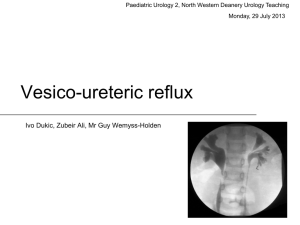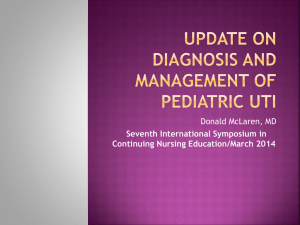Patrick C. Cartwright, MD - Ogden Surgical
advertisement
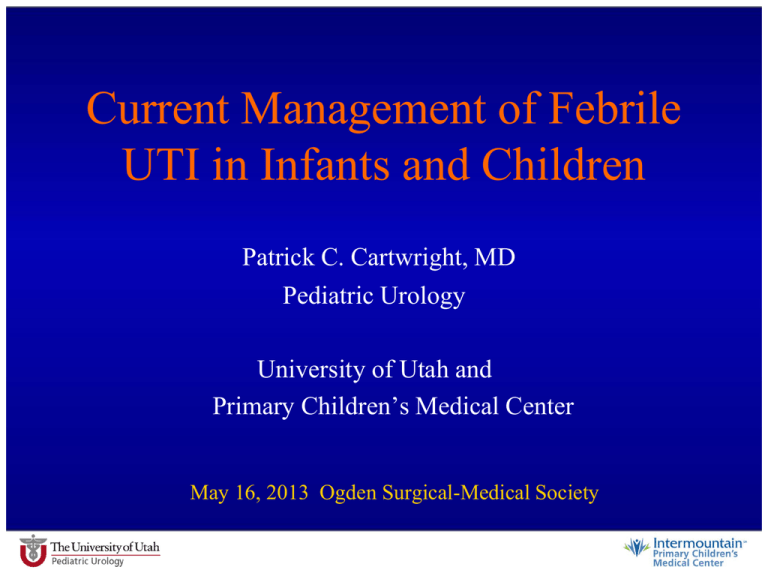
Current Management of Febrile UTI in Infants and Children Patrick C. Cartwright, MD Pediatric Urology University of Utah and Primary Children’s Medical Center May 16, 2013 Ogden Surgical-Medical Society Standard Approach to UTI Management in Childhood • • • • • • • Febrile UTI equals high risk for renal scar Reflux common in children with febrile UTI All children with febrile UTI – US and VCUG Reflux without UTI causes no renal damage Low grade reflux resolves, high grade does not Antibiotic prophylaxis prevents new scars Surgery for high-grade and non-resolved reflux New assessment of value of antibiotic prophylaxis following UTI Antibiotic prophylaxis may NOT decrease the incidence of recurrent UTI If this is true and VUR is just a risk factor for UTI, why should we test for VUR ? New Finding and Concept Some children who have high grade reflux are born with segmental renal dysplasia that will may not be obvious on US but will have a DMSA scan appearance identical to infection-induced renal scars. All scars are not secondary to UTI! Guidelines on UTI and Reflux • NICE Guideline on UTI in Children • AAP Guideline on Diagnosis and Management of Febrile UTI in Children 224 months • AUA Guideline on UTI and Primary Vesicoureteral Reflux in Children AAP Guideline Committee consideration • 6 studies of children with UTI and VUR treated with prophylaxis or no prophylaxis • Best available data shows that prophylaxis has no benefit, except in grade 5 VUR • Authors supplied non-published subset data to Committee (not made available to SOU) Action Statement 3 • To establish the diagnosis of UTI, clinicians should require both urinalysis results that suggest infection (pyuria and/or bacteriuria) and the presence of at least 50,000 CFU per mL of a uropathogen cultured from a urine specimen obtained through catheterization or SPA (evidence quality, C, Recommendation) Action Statement 5 • Febrile infants with UTIs should undergo renal and bladder ultrasonography (RBUS) (evidence quality: C; recommendation). Action Statement 6 • Action Statement 6a: VCUG should not be performed routinely after the first febrile UTI; VCUG is indicated if RBUS reveals hydronephrosis, scarring, or other findings that would suggest either high-grade VUR or obstructive uropathy, as well as in other atypical or complex clinical circumstances (evidence quality B; recommendation). • Action Statement 6b: Further evaluation should be conducted if there is a recurrence of febrile UTI (evidence quality: X, recommendation). Concerns with studies used as basis for AAP Guidelines determination • • • • • • UTI often determined by bag specimens Circumcision status is not noted in most Antibiotic compliance not known (5/6) Renal scarring often only by US Left off data from Swedish RCT No documentation of BBD is older kids (nor in the guidelines) Amalgamation effect – Simpson’s paradox Is this approach a big jump with no POSITIVE data? Concerns - continued • Even if there is no or little benefit to many from antibiotic prophylaxis, surgical VUR resolution has been shown to decrease febrile UTI (pyelo by DMSA scan) rates. • Analyses of US-based approaches are not encouraging. • BIG worry – inappropriate message to pediatricians and primary care docs – “you don’t need to worry much about UTI” – the broad brush effect. Will they feel that getting a VCUG in a specific patient (despite patient -specific worries) is now “sub-standard”? Potential Findings on RBUS • • • • Obstruction (1-5%) Ureteral Dilatation Bladder Wall Changes or other pathology Renal parenchymal abnormalities (combined: 10-15%) (best ordered with pre and post-void images) Sensitivity of RBUS for Renal Scar/Abnormality Detection • DMSA radionuclide scan – 100% • IVP – 55% • RBUS – 25% * RBUS is abnormal in 25% of kids with grade 4 and 62% of grade 5 VUR AUA Guidelines for the Management and Screening of Primary VUR in Children Guidelines committee performed a meta-analysis to determine the outcomes related to 5 topics: 1. Management of infants with VUR 2. Management of the child >1 yr with VUR 3. Management of children with VUR and BBD 4. Screening of siblings and offspring of pts with VUR 5. Screening of infants with PNH Is antibiotic prophylaxis useful? Effect of CAP on UTI 70% 60% 50% 40% 30% 20% 10% 0% CAP rate no CAP rate Swedish Reflux Trial 2009 UTI=194 Prophylaxis n=69 2 years Follow-up PNH=9 203 Endoscopic Rx n=66 128 girls 75 boys All with VUR Surveillance n=68 VCUG x 1-2 VCUG DMSA Bladder function Swedish Reflux Study Baseline DMSA Abnormalities Girls Boys Swedish Reflux Study: New Renal Scarring at 2 years Number of patients with new renal damage in 2 years FU What patient factors predict high risk for future febrile UTI and scar? • • • • • Age < 1 year White race High-grade VUR (grades 4 and 5) Presence of a renal scar/defect Bowel and bladder dysfunction Does VUR increase the risk of renal injury? What is the prevalence of renal scar based on number of UTIs? UTIs: 1 2 3 4 5 %scars 5% 10% 18% 33% 62% Are there infants after fUTI who might be helped if VUR is recognized? • • • • Increase Parental focus Improve Pediatrician/office focus Antibiotic prophylaxis in select sub-group? Surgical intervention potentially for those with high recurrent UTI/scar risk and low potentially for VUR resolution New Working Tenets of UTI and Reflux • Reflux is just one risk factor for UTI • Reflux does increase the risk of UTI being febrile and of scar formation after UTI • Many patients have congenital renal lesions that are most common in high grade VUR • Resolution of reflux does decrease pyelo rates • Many children with reflux are not predisposed to further UTI or scar These patients will do well without prophylaxis What are the risks of “Wait for 2” Approach? • Overall population – 5% increase scar rate, probably higher in select high risk cohort • Some may wait for more than 2 non-compliant – choice, distance, etc. complacent dim bulbs Unproven in POSITIVE trials What are risks of old “VCUG with 1” Approach • Morbidity of study – pain, UTI, cost, radiation • Over –treatment antibiotic prophylaxis surgical Truth? Likely lies somewhere in between We need a finer-toothed comb to know Bladder Dynamics UTI Pre-existing damage Immaturity Renal Injury Long-term Health Impact Critical Parameters in Reflux form the BASIS for Management B ladder A ge S ex I nfections S carring Risk of UTI Low High Mild Moderate Severe BBD School Age Toddler Infant Age I II III IV V Grade None Few Recurrent Infections None Scarring Moderate Severe Risk assessment in reflux • Clinical decisions should be based on a risk assessment to tailor evaluation and treatment to the individual child’s risk of acute illness (pyelonephritis) and scarring. • Incorporate parental risk perception into decision and revisit periodically over time. (Ogan, J Urol, 2001) RIVUR Randomized Intervention for Children with Vesicoureteral Reflux • NIH/NIDDK sponsored clinical trial on the efficacy of CAP in children with VUR • Randomize 600 children (40 centers) ages of 2 -72 months Grade I-IV after 1st UTI TMP-SMX vs. placebo • DMSA scan within 10 weeks of UTI • Repeat DMSA at 12 and 24 months • 2 year study with incidence and character of UTI as primary endpoint and renal scarring, treatment failure, and antimicrobial resistance as secondary endpoints Future Directions for UTI and VUR • • • • Rapid UTI detection Non-invasive imaging for VUR Genetic profile for UTI/scarring risk Urinary proteome evaluation for important parameters – UTI risk, renal inflammation or scar • Incorporate RIVUR trial data • Need a prospective – “Wait for 2” trial My thoughts ?? Thanks to Ogden Surgical-Medical Society
